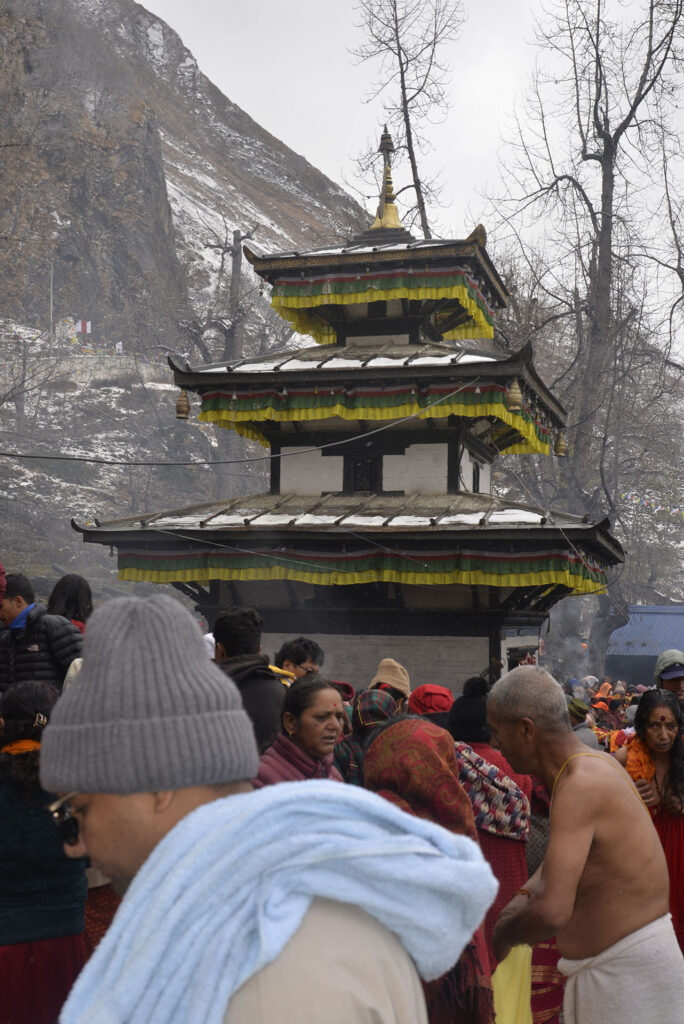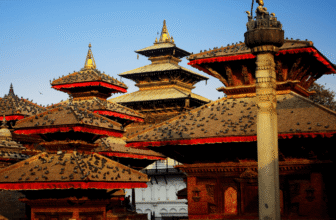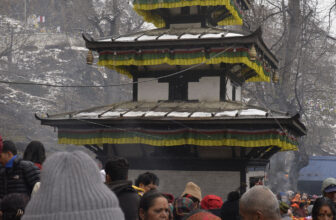
Muktinath Temple, or the “Temple of Salvation,” is a sacred pilgrimage site in Nepal. Located in the Mustang district at an altitude of 3,800 meters, it holds immense spiritual and historical significance for both Hindus and Buddhists.
For Hindus, it is one of the 108 Divya Desams, sacred Vishnu temples believed to grant liberation (moksha) from the cycle of birth and rebirth. Buddhists revere it as a place where Guru Rinpoche (Padmasambhava), the founder of Tibetan Buddhism, meditated during his journey to Tibet.
The temple sits high in the Himalayas, surrounded by dry valleys and snowcapped peaks. This makes the journey difficult, yet it offers spiritual rewards. Muktinath has long symbolized unity between these two religions. Its sacred flame and 108 holy water spouts draw pilgrims and travelers globally.
Ancient Origins and Etymology
“Muktinath” comes from two Sanskrit words. “Mukti” means liberation, and “Nath” means lord or protector. Together, it means “Lord of Liberation.” The temple represents the ultimate spiritual goal of freedom from birth and death.
Historical references trace Muktinath back to the 1st Century AD. Archaeological discoveries in Mustang reveal early settlements. They also show trade routes linking Nepal, Tibet, and India. Merchants, monks, pilgrims, and scholars traveled these routes. They shaped the site’s spiritual and cultural growth. The temple likely served as a worship center long before the current shrine was built.
Mythological Foundations and Legends
Muktinath Temple matters due to its rich history and the many myths linked to it. These stories show their significance for both Hindus and Buddhists. These stories give the temple its divine aura, making it a spiritual beacon across faiths.

Hindu Legends
According to Hindu belief, Muktinath has a strong connection with Lord Vishnu. Mythology tells us that Vishnu transformed into a Shaligram. People find this sacred black stone in the Kali Gandaki River, near Muktinath. These Shaligrams represent Vishnu. People see them as a sign of his lasting presence in the area.
Vrinda, the devoted wife of the demon Jalandhar, is connected to another famous legend. After Vishnu deceived her, she cursed him to become a stone. Vishnu showed his love by becoming the sacred Shaligrams in the Kali Gandaki. Those who worship these stones find salvation.
Muktinath is also connected to the Shakti Peethas. According to Hindu scripture, when Lord Shiva wandered carrying the body of Goddess Sati, her body parts fell across different places. This created 51 sacred Shakti Peethas. People believe Muktinath to be one of them, sanctifying it as a place of divine feminine energy.
Buddhist Traditions
Buddhists also revere Muktinath. Guru Rinpoche meditated here on his journey to Tibet, giving the land spiritual power. People see the temple as a home for Dakinis, the goddesses of wisdom and energy. It is also connected to Avalokiteshvara, the Bodhisattva of compassion.
Muktinath is a unique spiritual place. It blends themes of liberation, compassion, and divine energy.
Scriptural References
Hindu scriptures often call Muktinath a sacred spot. Here, devotees can find liberation, or moksha. The Vishnu Purana names Muktinath as one of the eight holiest shrines of Lord Vishnu. Worshipping here can lead to salvation. The Gandaki Mahatmya is a text focused on the Gandaki River. It highlights the Shaligrams found in its waters. Devotees see these stones as forms of Vishnu. This belief enhances the temple’s spiritual value. It makes the area a lasting pilgrimage site.
Muktinath also has a significant connection to the Mahabharata. The Pandavas, after the Kurukshetra War, traveled through the Himalayas in search of liberation. They visited Muktinath to pray for peace and freedom from rebirth. This shows how important the temple is in epic stories.
Other Puranas, like the Skanda Purana and Varaha Purana, call Muktinath a moksha-kshetra. This means it is a place of liberation. Muktinath is more than a temple. It’s a spiritual center. For centuries, gods, sages, and humans have come here seeking freedom.
Historical Construction and Royal Patronage
Muktinath Temple has a rich history. It reflects centuries of devotion, changes in architecture, and support from royalty.
Early Temple Structures (16th Century)
The earliest temple at Muktinath dates back to the 16th century. People built it to hold the sacred Vishnu idol. Archaeologists say this first shrine was simpler than today’s pagoda-style temple. It may have been a small stone structure with basic protective walls. Before the builders constructed the temple, people worshiped Shaligrams. They also revered the sacred waters of the Kali Gandaki River. Local stories share this history.
Current Temple Construction (1815 AD)
Queen Subarna Prabha Devi built the current pagoda-style temple in 1815 AD. She wanted to preserve the temple for future generations. Builders used the classic Nepali pagoda design. They also included key natural features, like the 108 water spouts and the eternal flame. The Shah Dynasty funded renovations, expansions, and maintenance of the temple. This support helped keep it a key pilgrimage center.
Malla and Shah Dynasty Contributions
The Malla kings ruled from the 12th to the 18th century. They were important in creating pilgrimage routes to Muktinath. They linked it with other holy sites in Nepal and India. These routes made it easy for traders and religious travelers to reach the temple. The Shah Dynasty later recognized Muktinath as a protected religious site. They provided royal support to ensure its upkeep.
Muktinath Temple started as a small shrine. Over the years, royal support helped it grow into a major spiritual site. It blends religious tradition with stunning architecture.
Religious Classifications and Sacred Status
Muktinath Temple holds a special place in both Hindu and Buddhist traditions. Pilgrims from both faiths hold it in great respect.
Hindu Recognition
Hindus view Muktinath as one of the 108 Divya Desams. These are the most sacred temples of Lord Vishnu, as noted in ancient scriptures. The temple is a Svayam Vyakta Kshetra. This means people believe the deity is self-manifested, not made by humans. Muktinath connects to the Shakti Peethas, which are sites of divine feminine energy. It is also part of Nepal’s Char Dham, the four important pilgrimage spots.
Buddhist Recognition
Buddhists also regard Muktinath as one of the 24 Tantric sites. People consider these places sacred for meditation and spiritual growth. Some believe it is the home of Dakinis. These are celestial beings linked to wisdom and energy. The temple, called Chumig Gyatsa or “Hundred Waters,” has 108 water spouts that play a key role in rituals. Pilgrims believe that bathing under these spouts brings spiritual blessings and benefits.
Sacred Geography and Natural Phenomena
A key feature of the temple is the 108 water spouts, called Muktidhara. These spouts send a steady stream of cold mountain water over pilgrims. Both Hinduism and Buddhism consider the number 108 sacred. It represents cosmic completeness, the universe, and the path to enlightenment. Pilgrims bathe under these spouts to purify their bodies and souls.
A unique feature is the eternal flame, or Jwala Mai. It burns nonstop from natural gas that seeps through the rocks. The flame and flowing water exist together, creating a rare natural wonder. This illustrates the balance between fire and water in a spiritual context. Fire stands for divine energy and change. Water symbolizes purity and life. Pilgrims view this as a symbol of harmony and freedom. It represents the connection between the material and spiritual worlds.
The temple’s architecture integrates these natural wonders. Pilgrims can enjoy both the physical beauty and spiritual power of Muktinath. The temple connects height, holy water, and the eternal flame. These elements link nature with spirituality.
Shaligram Stones and Sacred Geology
Muktinath Temple’s spiritual power comes from the Kali Gandaki River, which flows through Mustang. This river is famous for its Shaligram stones, black fossils that devotees believe are forms of Lord Vishnu. These stones formed over millions of years from ancient ammonite fossils. They hold both geological and religious importance. Devotees collect Shaligrams as holy objects and worship them at home or in temples, showing Muktinath’s central role in Vishnu devotion.
Shaligrams form through natural processes. They come from fossilized remains of marine creatures. These riverbeds from prehistoric times preserve the remains. Sacred symbols representing the eternal universe and divine energy are their spiral patterns. Pilgrims touch or pray to these stones, seeking blessings and purification. This belief makes Shaligrams vital in Hindu worship.
Nearby Damodar Kund adds more holiness to the site. This sacred pond gets water from mountain springs. It’s a place for ritual bathing. Devotees come here to cleanse their sins and earn spiritual merit. Damodar Kund and Shaligrams enhance Muktinath’s reputation as a key site for liberation (moksha) and spiritual connections.
Muktinath combines natural geology with sacred traditions. This mix highlights both science and spirituality. The temple is a key religious site. It presents a distinctive representation of the divine presence in the Himalayas.
Temple Architecture and Interior
Built in pagoda-style, the temple features:
- Golden Vishnu idol at the center.
- Statues of Lakshmi, Garuda, and other deities.
- Tiered roofs symbolize spiritual ascent.
- Carvings that reflect values of morality, devotion, and liberation.
Cultural Exchange and Historical Pilgrimages
Muktinath Temple has long been a meeting point of culture, trade, and spirituality. It lies along the ancient salt trade route connecting Tibet and India. Traders, pilgrims, and monks all came to the temple. It became a center for trade and spiritual exchange. This place mixes Hindu and Buddhist traditions. You can see this in their shared rituals, temple designs, and religious practices.
The temple served as a spiritual link between India and Tibet. It drew in devotees from both areas. Historical records show visits by great spiritual leaders. People think that Adi Shankaracharya meditated here. He aimed to spread Advaita Vedanta principles in Nepal. Guru Rinpoche (Padmasambhava) also meditated at Muktinath. This deepened its importance in Buddhist tantric traditions. Today, it remains a sacred site for Tibetan pilgrims.
Royal pilgrimages also increased the temple’s importance. Kings from the Malla and Shah dynasties visited often. They maintained the temple, offered support, and protected sacred objects. They created safe paths for pilgrims. This helped more people reach the high-altitude sanctuary.
Modern Era Development
In the 20th and 21st centuries, Muktinath enhanced facilities for pilgrims. This included better trekking paths, shelters, and sanitation. Helicopter services now provide access from Pokhara.
Conservation efforts protect the temple, water spouts, Shaligrams, and the surrounding nature. Modern developments balance tradition with accessibility.
Religious Harmony in Practice
Muktinath Temple shows religious harmony. Hindu and Buddhist traditions coexist in harmony. Hindu priests and Buddhist nuns team up. They perform rituals and guide pilgrims while also respecting each other’s practices. This teamwork enables both faiths to practice their sacred rites in harmony. It fosters mutual respect and understanding.
The temple is a sacred space for everyone. It supports various worship styles, prayer ceremonies, and meditation practices. Pilgrims often witness Hindu and Buddhist rituals together. This shows that devotion crosses religious boundaries.
This model reflects Nepal’s long tradition of tolerance and diversity. Muktinath fosters spiritual growth and symbolizes unity. It brings various communities together in devotion. The temple encourages collaboration and inclusivity. This inspires visitors to value compassion, respect, and devotion. As a result, it stands as a symbol of religious harmony in the Himalayas.
Frequently Asked Questions (FAQs)
Where is Muktinath Temple located?
Why is Muktinath Temple important for Hindus?
Why do Buddhists worship at Muktinath?
What is the meaning of “Muktinath”?
What are Shaligram stones and why are they sacred?
What is special about the 108 water spouts at Muktinath?
What is the eternal flame (Jwala Mai) at Muktinath?
Is Muktinath part of the Char Dham in Nepal?
Can both Hindus and Buddhists perform rituals at Muktinath?
Conclusion
Muktinath Temple still holds deep spiritual meaning for both Hindu and Buddhist devotees. Sacred waters, an eternal flame, and divine idols provide pilgrims with purification, devotion, and peace. This has made it a respected destination for centuries.
But Muktinath is more than a temple — it is a journey. From ancient trade routes to modern tours like Muktinath Temple-Darshan, every path reflects the balance of struggle and salvation.
For those planning their pilgrimage, Debyani Tours and Travels offers trusted services to guide you through the Himalayas. From trekking to helicopter tours, they ensure a safe, memorable, and spiritually enriching journey.
Muktinath Temple is a timeless symbol of freedom and peace. It stands tall in the Himalayas. Here, faith, culture, and nature come together in harmony. For each pilgrim, it’s more than a temple. It’s a gateway to spiritual awakening, reflection, and a connection with the divine.






